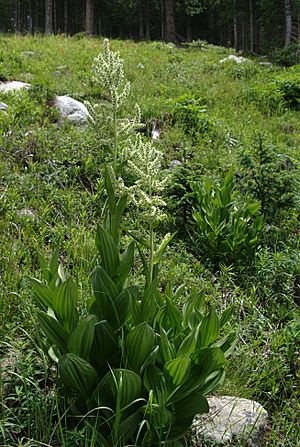California corn lily facts for kids
Quick facts for kids California corn lily |
|
|---|---|
 |
|
| Scientific classification | |
| Genus: |
Veratrum
|
| Species: |
californicum
|
The Veratrum californicum, also known as the California corn lily or white false hellebore, is a very poisonous plant. It grows naturally in mountain meadows across southwestern North America. You can find it in places like the Sierra Nevada and Rocky Mountains. Its range stretches from Alaska in the north down to Durango, Mexico.
This plant prefers very moist soil. It often covers large areas in dense groups near streams or in wet meadows. It can grow quite tall, reaching 1 to 2 meters (about 3 to 6 feet). It has a straight stem that looks a bit like a cornstalk because it's covered in many leaves. The bright green leaves can be over a foot long and have clear veins. Its flowers are about an inch wide. They grow in clusters at the top of the stem. Each flower has six white petals, a green center, and a unique three-branched pistil.
Veratrum californicum has a special way of growing called mast seeding. This means that in most years, only a few plants will bloom and make seeds. But in certain years, many plants will bloom and produce a lot of seeds all at the same time.
Types of California Corn Lily
There are two main types, or varieties, of the California corn lily:
- Veratrum californicum var. californicum – This type is found from Washington state all the way down to Durango, Mexico.
- Veratrum californicum var. caudatum – This type grows in Idaho, Washington, Oregon, and northern California.
Why This Plant Can Be Dangerous
The California corn lily contains special chemicals like jervine and cyclopamine. These chemicals can be very harmful to animals that eat the plant. For example, if animals like sheep or horses graze on this plant, it can cause serious birth defects in their babies. These chemicals affect how a baby animal develops before it is born. This is why it's important for farmers to keep their animals away from areas where this plant grows.
Gallery




